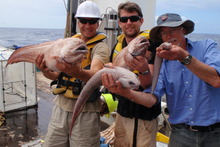Fish Talk e-Zine
Sunday, 17 February 2013
New species of fish discovered in ocean trench near NZ
By James Ihaka Email James
An expedition to one of the deepest ocean trenches has discovered a new species of fish and another not previously caught in the southwest Pacific, giving scientists a better understanding of biodiversity in the deep seas around New Zealand.
Niwa scientists working with colleagues from the University of Aberdeen and Te Papa Museum discovered a new species of eelpout and new records of a rattail fish that has not previously been caught in the southwest Pacific on a recent voyage to the Kermadec Trench.
They also found a rattail that has not been caught in New Zealand waters for more than 100 years, a large deep-sea cusk eel and large numbers of amphipods, such as marine sand-hoppers.
Niwa principal scientist Dr Malcolm Clark said the voyage was part of a continuing series to investigate how the biodiversity in the trench differed from that at shallower depths and in other trench systems.
He said the international collaboration allowed local researchers to use scientific equipment they do not have and to sample places that would otherwise be inaccessible.
"The results from this deep exploration are giving us a much better understanding of biodiversity in the deep sea around New Zealand, and enable us to better assess potential risks to the ecosystem from future climate change and even human activities, which may include seabed mining," he said.
Voyage leader Dr Alan Jamieson, from the University of Aberdeen, said they had recovered a considerable amount of data, which would be added to information collected from the Kermadec Trench over three previous voyages on RV Kaharoa by the Aberdeen-Niwa team.
"A voyage such as this is testament to how feasible scientific research in the deep sea has become," he said.
"The technological challenges of the past no longer exist, and shouldn't limit our responsibility to learn about and understand the deep sea to help ensure the long-term health of the deep oceans, one of the largest environments on earth."
In seven days of sampling, the scientists - who used landers with cameras attached that free-fall to the seafloor, as well as baited fish traps - caught more than 100 fish and took more than 6500 photographs.
They covered waters well below the depth that light penetrates, sampling depths between one and six kilometres on the edge of the Kermadec Trench - one of the deepest places on Earth, with depths exceeding 10km.
The new specimens will be held at the National Fish Collection at Te Papa while the amphipod samples will be registered in Niwa's invertebrate collection.
Dr Clark said a further expedition to the New Hebrides Trench was planned for October.
By James Ihaka Email
Full Article: nzherald
More News: GoFishTalk
Subscribe to:
Comments (Atom)
